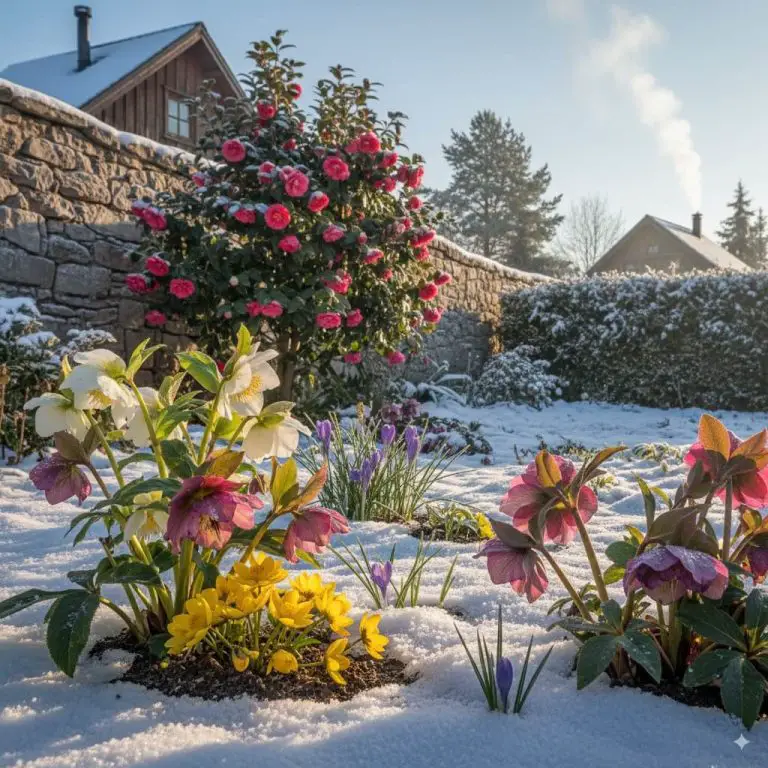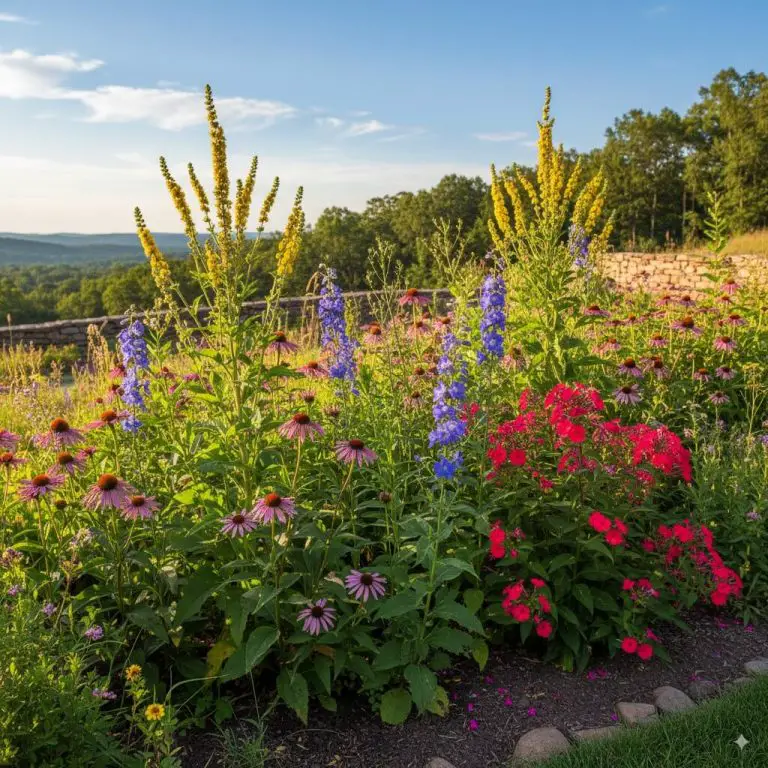Flowering Native Plants – Create A Low-Maintenance, Pollinator
Have you ever looked at a stunning garden in a magazine and thought, “I could never do that”? It’s a common feeling. We dream of a yard bursting with color, but the reality often involves endless watering, battling mysterious pests, and using fertilizers we can’t even pronounce. It can feel like a constant, uphill battle.
I promise you, there is a simpler, more rewarding way to garden. The secret isn’t about working harder; it’s about working smarter with nature. By embracing flowering native plants, you can unlock a world of effortless beauty that’s not only easier on you but also incredible for your local ecosystem.
In this complete guide, we’ll walk you through everything you need to know. We’ll explore the amazing benefits of going native, how to choose the perfect plants for your specific yard, and the simple care practices that will have your garden thriving. Get ready to create a stunning, sustainable sanctuary that buzzes with life!
What's On the Page
- 1 Why Choose Native Flowers? The Surprising Benefits for You and Your Garden
- 2 Getting Started: Your Guide to Choosing the Right Flowering Native Plants
- 3 How to Plant and Care for Flowering Native Plants: Best Practices for Success
- 4 Troubleshooting Common Problems with Flowering Native Plants
- 5 Frequently Asked Questions About Flowering Native Plants
- 6 Your Native Garden Journey Begins Now
Why Choose Native Flowers? The Surprising Benefits for You and Your Garden
So, what’s all the buzz about? Choosing to plant native species is one of the most impactful decisions a gardener can make. This isn’t just a trend; it’s a foundational principle of eco-friendly flowering native plants. The benefits extend far beyond just pretty blooms.
Built for Your Backyard
Native plants are, by definition, perfectly adapted to your local environment. They have evolved over thousands of years to thrive in your region’s specific soil, rainfall patterns, and temperature extremes. What does this mean for you?

🌿 The Companion Planting & Gardening Book (eBook)
Bigger harvests, fewer pests — natural pairings & simple layouts. $2.40
Get – $2.40
🪴 The Pest-Free Indoor Garden (eBook)
DIY sprays & soil tips for bug-free houseplants. $1.99
Get – $1.99- Less Watering: Once established, most natives have deep root systems that are incredibly efficient at finding groundwater, dramatically reducing your need to water.
- No Fertilizer Needed: These hardy plants are accustomed to the natural nutrient levels in your soil. They don’t need—and often dislike—the chemical fertilizers required by many exotic ornamentals.
- Tough and Resilient: They can handle your area’s weather, from summer heatwaves to winter freezes, with grace.
A Buffet for Pollinators
This is where the magic really happens. Native plants and local wildlife have a special, co-evolved relationship. Your garden becomes more than just a collection of plants; it transforms into a vital, living habitat.
The benefits of flowering native plants for wildlife are immense. They provide the specific nectar, pollen, seeds, and host-plant services that native bees, butterflies, birds, and other beneficial insects need to survive and reproduce. Planting a native Coneflower or Milkweed is like rolling out a welcome mat for Monarch butterflies and Bumblebees.
Low-Maintenance Beauty
Because they are so well-adapted, native plants are naturally more resistant to local pests and diseases. You can say goodbye to most chemical pesticides and fungicides. This creates a healthier space for your family and pets while saving you time and money. It’s the core of sustainable flowering native plants: less work for you, more support for the environment.
Getting Started: Your Guide to Choosing the Right Flowering Native Plants
Feeling inspired? The next step is the most exciting part: choosing your plants! The golden rule of all gardening, especially with natives, is “right plant, right place.” This section of our flowering native plants guide will show you how to do just that.
Know Your Zone and Your Yard
Before you buy a single plant, take a moment to observe your space. This is one of the most crucial flowering native plants tips I can offer.
- Light Conditions: Does the spot get 6+ hours of direct sun (full sun), 4-6 hours (part sun/shade), or less than 4 hours (full shade)? Be honest!
- Soil Type: Is your soil heavy and sticky when wet (clay), gritty (sandy), or dark and crumbly (loam)? Most natives aren’t picky, but some have preferences. You can do a simple “jar test” to find out.
- Moisture Levels: Does water drain away quickly, or does it tend to pool after a rain? Note areas that are consistently dry or damp.
Knowing these three things will empower you to select plants that will thrive naturally, not just survive.
Top Picks for Beginners (A Few Ideas to Start)
While the “best” natives are specific to your exact location, here are some widely-adapted, easy-to-grow favorites that are perfect for beginners across different regions.
- For the Northeast & Midwest: Purple Coneflower (Echinacea purpurea), Black-Eyed Susan (Rudbeckia hirta), and Bee Balm (Monarda fistulosa). Don’t worry—these flowers are perfect for beginners!
- For the Southeast: Lanceleaf Coreopsis (Coreopsis lanceolata), Blazing Star (Liatris spicata), and Butterfly Weed (Asclepias tuberosa).
- For the West & Southwest: California Poppy (Eschscholzia californica), Yarrow (Achillea millefolium), and Penstemon species (like Rocky Mountain Penstemon).
Pro Tip: Use online resources like the National Wildlife Federation’s Native Plant Finder or Audubon’s plant database. You just enter your zip code, and they provide a tailored list of powerhouse plants for your area.
Where to Find True Native Plants
Your local big-box store might have a few options, but they often carry “nativars”—cultivars of native plants bred for specific traits like color or size. While beautiful, they may not offer the same ecological benefits. For the best results, seek out local native plant nurseries, seasonal plant sales held by conservation districts, or reputable online suppliers that specialize in plants for your region.
How to Plant and Care for Flowering Native Plants: Best Practices for Success
You’ve got your plants, and you’re ready to get your hands dirty. Learning how to flowering native plants are cared for is refreshingly simple. This flowering native plants care guide focuses on setting them up for long-term, independent success.
Planting for a Thriving Future
The best time to plant is typically in the spring or fall, which avoids the stress of summer heat. Dig a hole that is about twice as wide as the plant’s container but no deeper. You want the top of the plant’s root ball to be level with the surrounding soil. Gently tease out any circling roots, place the plant in the hole, and backfill with the native soil you removed. There’s no need to add fancy amendments or fertilizers!
The “Less is More” Watering Strategy
Water your new plants thoroughly after planting and continue to provide about an inch of water per week for the first growing season if it doesn’t rain. This helps them establish strong roots. After that first year? You can relax. Most established native plants will only need supplemental water during prolonged, severe droughts.
To Fertilize or Not to Fertilize?
In a word: don’t. Native plants are adapted to average, “lean” soil. Adding commercial fertilizers often leads to weak, leggy growth and fewer flowers. The best way to enrich your soil is to simply let leaves decompose where they fall or add a thin layer of natural compost in the spring.
Pruning and Deadheading (The Native Way)
While you can deadhead (remove spent blooms) on some plants like Coreopsis to encourage a second flush of flowers, it’s not always necessary. One of the best flowering native plants best practices is to leave the seed heads on plants like Coneflower and Black-Eyed Susan through the fall and winter. They provide crucial food for birds like finches and add beautiful structural interest to the winter garden.
Troubleshooting Common Problems with Flowering Native Plants
Even these hardy plants can sometimes face challenges, especially when they’re getting established. Don’t panic! Here’s a look at some common problems with flowering native plants and their simple solutions.
“My Native Plants Aren’t Flowering!”
This is a frequent concern for new native gardeners. The cause is usually one of these three things:
- They’re Too Young: Many perennials follow the “sleep, creep, leap” pattern. The first year they sleep (focus on root growth), the second they creep (more foliage), and the third year they leap (abundant flowers). Be patient!
- Incorrect Sunlight: A sun-loving Black-Eyed Susan planted in deep shade will produce lots of leaves but few, if any, flowers. This is why that initial observation is so important.
- Too Much Kindness: Overwatering or adding rich fertilizer can signal the plant to focus on lush, green growth instead of producing blooms.
“They Look Leggy or Floppy.”
This usually happens for two reasons: too much shade, causing the plant to stretch for light, or soil that is too rich. For some taller species like Joe Pye Weed or Asters, you can perform the “Chelsea Chop” in late spring—cutting the plant back by about a third. This encourages a sturdier, bushier plant that is less likely to flop over later in the season.
Dealing with Pests and Diseases Naturally
A healthy native garden is a balanced ecosystem. You might see some aphids on your Milkweed, but soon after, you’ll see ladybugs arriving to feast on them. The key is to avoid reaching for chemical sprays. By planting a diversity of native species, you will attract beneficial insects that act as your own personal pest control squad, a cornerstone of any eco-friendly flowering native plants strategy.
Frequently Asked Questions About Flowering Native Plants
What’s the difference between a “native” plant and a “nativar”?
A “native” plant is a species that occurs naturally in your specific region without human introduction. A “nativar” is a cultivar (cultivated variety) of a native plant that has been selected or bred by humans for a specific trait, like double flowers or a different color. While nativars can be beautiful, research suggests that the original native species, or “straight species,” are often more valuable to pollinators.
Can I grow flowering native plants in containers?
Absolutely! Many smaller native plants, like Prairie Smoke (Geum triflorum) or various Penstemon species, do wonderfully in pots. Just be sure to use a large enough container with excellent drainage and a potting mix that isn’t too rich in fertilizers. Container plants will also require more regular watering than those in the ground.
How long does it take for native plants to get established?
Remember the gardener’s mantra: “The first year they sleep, the second year they creep, and the third year they leap.” It takes time for perennials to establish deep root systems. Your patience will be rewarded with robust, healthy, and beautiful plants for years to come.
Your Native Garden Journey Begins Now
Creating a garden filled with flowering native plants is more than just a gardening project; it’s a way to reconnect with your local landscape and make a real, positive impact on the world right outside your door.
You’re not just planting flowers—you’re creating a habitat, supporting pollinators, and building a resilient, low-maintenance garden that will bring you joy for years. You don’t have to tear out your whole yard to start. Begin with one plant. Add a small patch of Coneflowers or a drift of Bee Balm. Watch it come alive.
You have the knowledge and the power to create something truly beautiful and meaningful. Go forth and grow!
- Conifers For Small Gardens – Your Ultimate Guide To Year-Round Beauty - December 10, 2025
- Shade Conifer Trees – Cultivating Evergreen Splendor In Tricky Garden - December 10, 2025
- Conifer Flowers – Unveiling Their Hidden Beauty And How To Cultivate A - December 10, 2025



